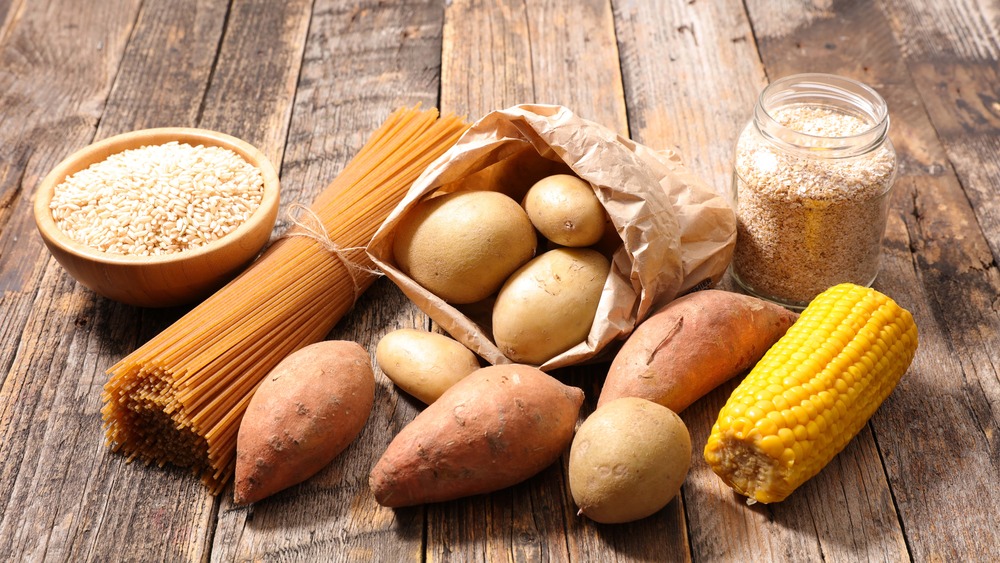For longer and more intense training sessions, extra portions of carbohydrates are required. Otherwise, there will be a drop in performance.
 Author: David Schaad, physiotherapist MSc at Medbase
Author: David Schaad, physiotherapist MSc at Medbase
Triathletes lay the foundation for good endurance performance not only with a good training plan, but also with a regularly balanced diet.
Carbohydrates are stored in the form of glycogen in the muscles and liver. When you train long or hard, your glycogen stores are depleted. However, if you consume additional sugars (saccharides) during this time, you can “save” your glycogen reserves in the liver for the final sprint.
Carbohydrates for faster energy supply
Carbohydrates do not provide as many kilocalories as fats, but they do provide energy more effectively than fat or protein: firstly, because the energy from carbohydrates is available to you more quickly. Secondly, because your body gets more energy out of carbohydrates per litre of oxygen inhaled compared to other food components.
To keep your energy stores in your liver and muscles well-filled, you need between six and twelve grams of carbohydrates per kilogram of body weight every day, depending on the amount of exercise you do. With full glycogen stores, you can last longer at high intensities.
Extra carbohydrates are only necessary during intense training sessions
As long as your training is in the basic endurance range, your body will primarily use fat reserves as an energy source. This is also the case with casual training sessions of no more than five hours per week or training sessions that last no more than 90 minutes. Then you don’t need an extra portion of pasta to provide carbohydrates.
Training sessions that last longer than 90 minutes, on the other hand, require additional carbohydrate intake.
Glycogen stores: empty after 90 minutes at the latest
As a rule of thumb, the body consumes 30 to 60 grams of carbohydrates per hour during light exercise; during intense exercise it can be more than 90 grams per hour. During intense endurance exercise, however, even previously high glycogen stores are exhausted after about 75 to 90 minutes. This is why you cannot avoid additional carbohydrate intake during longer training sessions if you do not want to risk a drop in performance.
In the high-intensity training range, the body can burn almost no more fat reserves. A “low carb” diet in this situation makes it difficult to achieve the required performance. Whether training with low glycogen stores can improve fat burning is still unclear.
During training: easily digestible carbohydrates
During high-intensity exercise, it’s best to give your body what your muscles need to provide energy quickly: easily digestible carbohydrates. They help you to increase your power output and perform at your maximum capacity. Easily digestible carbohydrates also delay fatigue and improve your coordination and cognition.
For example, sweetened drinks with household sugar (sucrose), glucose (dextrose) and fructose (fruit sugar), white flour – many things that are actually considered unhealthy can be useful during endurance exercise.
Performance test at Medbase
The sports scientists and sports physicians at Medbase check your performance level with an endurance test. Based on this, they explain to you in a clear and uncomplicated way how you can optimally incorporate the results into your training.
Book now
Preparation before a competition
Before a race, find out which drinks, gels and foods the organiser will be offering at which stand and “train” your stomach and intestine beforehand with these products in the same order. This will help you avoid unpleasant surprises such as exercise-induced diarrhea or abdominal cramps because your digestive system is overwhelmed by the quantity or composition of the products.
Carboloading guide
Before a competition, it is a good idea to increase the amount of carbohydrates you consume so that you start the race with well-filled glycogen stores (carboloading). Most athletes consume ten grams of carbohydrates per kilogram of body weight per day about 24 hours before the start of the race, while reducing their training at the same time.
Manage energy intake well on race day
Two to three hours before the start, it is ideal to eat a meal that contains around one to four grams of carbohydrates per kilo of body weight. Keep in mind the time interval before the start so that you don’t use up the energy too quickly.
In the first 2.5 hours of the race you will consume about 30 to 60 grams of carbohydrates per hour. After that, you will consume up to 90 grams per hour – that’s a lot. It’s best to divide your carbohydrate intake into several portions, about 20 minutes apart, so as not to overload your digestion.
Drinks have the advantage that they also provide fluid replacement. Ideally, they should contain about six percent sugar. About 1.5 litres per hour will provide you with enough energy.
Towards the end of a race, cola can be useful. Not only does it provide energy and hydration, but because of the caffeine it contains, it can also improve your concentration on the last leg.
Combining glucose and fructose for more energy
But beware: the digestive tract can only use a maximum of 1.2 grams of glucose per minute. If you consume more, the cellular transport mechanisms in the intestine will be overwhelmed.
If you need more carbohydrates, combine glucose and fructose (if you can tolerate fructose), because fructose enters the cells in a different way than glucose. Many sports drinks and gels contain both sugars.
After the competition
After exercise, it is important to replenish your glycogen reserves. Glycogen synthesis is high two hours after exercise. If you don’t have to perform at your best the next day, you can take your time with carbohydrate intake. Then replenish your glycogen stores with your usual balanced diet.
TIPS:
- Carbohydrates are only one part of the “big picture” of training. Therefore, do not focus exclusively on them.
- When exercising for less than an hour, you can stimulate yourself by rinsing your mouth out with a sweet lemonade or something similar. This alone will activate the brain’s reward centre.
- To determine the amount of carbohydrates you need to do a little math, because most carbohydrate amounts are listed on the package per 100 grams, not per portion.
- Test out which carbohydrates you tolerate well and which portion sizes suit you best. For example, if you cannot tolerate fructose, be careful because many sports drinks and gels contain fructose.
- If you have an adequate supply of carbohydrates, protein supplements are of no advantage if you want to improve your performance.
- Sports drinks and gels are usually equally well tolerated. Important: Always combine the gel with liquid.
Who is Medbase?
Medbase is the largest multidisciplinary sports medicine network in Switzerland and offers specialised sports medicine services for athletes, clubs and sports associations at all levels of activity in the areas of sports medicine, sports physiotherapy, performance diagnostics and training advice.
